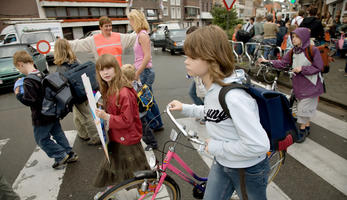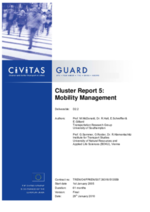Mobility management for schools
Summary
Since 2002, Ghent City Council has been supporting schools in developing a school travel plans (STPs). Up to now they have worked solely with primary schools. With this measure, the objective is to implement school mobility plans in secondary schools.
Implementing sustainable mobility
The objective of this measure is to implement STPs for all the secondary schools situated in the ELAN corridor and based on the experience to extend the measure to as many secondary schools as possible. An STP encompasses all the issues relevant to journeys to and from the school and includes concerns about safety and health, and proposals for ways to make improvements. It is also a means of gathering the ideas and contributions of different groups of people, to help to solve problems. The main elements will be common to all STPs but each plan is unique because it is produced and owned by a particular school and addresses that school's needs. By concentrating the implementation of STPs in one zone, barriers in several school travel plans can be tackled in a more efficient way.
Progress
 The first step in drafting a STP is to form an action group or committee, as the success of a school travel plan depends on informing, consulting, and involving everyone with an interest in the project. This includes pupils, parents, teachers, governors, school premises manager, local residents, councillors, health promotion officers, and perhaps public transport operators. After the action group is formed, the current situation (e.g. location, number of students, modal split) will be described in the STP. The main answers will be the result of a survey amongst the students. Also the current situation concerning public transport, road, bicycle and pedestrian network will be analysed.
The first step in drafting a STP is to form an action group or committee, as the success of a school travel plan depends on informing, consulting, and involving everyone with an interest in the project. This includes pupils, parents, teachers, governors, school premises manager, local residents, councillors, health promotion officers, and perhaps public transport operators. After the action group is formed, the current situation (e.g. location, number of students, modal split) will be described in the STP. The main answers will be the result of a survey amongst the students. Also the current situation concerning public transport, road, bicycle and pedestrian network will be analysed.
Finally, the plan is a statement of problems, which need to be addressed, and a strategy for overcoming or reducing them by a number of initiatives, which will make journeys to and from school safer and healthier. The initiatives will often include promotional activities, such as training, better facilities, enhanced public transport services and safety improvements to the physical environment. A discussion will be organised with the students concerning their mobility behaviour and a special educational map will be produced. With this map the schoolboys and girls will be able to analyse their trip from home to school and back.
During the school year 2009-2010, six schools participated in the CIVITAS School Competition. They came up with innovative ways to convince their fellow classmates to come to school in a more sustainable way. The schools presented their ideas to a jury and they chose three winners that were awarded money to implement sustainable measures in their schools.
Some remarks:
Schools receive too many requests to step into projects
personal guidances and communication are crucial
a competition with valubale pricesis a stimulans for youngsters to act
Outcomes
Ghent expects the measure will:
- Improve the modal share for public transport, cycling and walking by 5 percent;
- Raise awareness of safe and sustainable home-school transport;
- Decrease barriers to the use of safe and sustainable travel modes;
- Increase the use of bike and foot for home-school trips;
- Introduce school travel plans for all secondary schools situated within the corridor;
- Develop a traffic map for high school students; and
- Educate 3,000 students on traffic safety.
Outcomes:
- Results of modal shift were quite positive
A modal shift could not be measured for the first two editions since the after data were missing. But the results of 2011-2012 were quite positive. Compared to the modal split before the campaigns, a decrease of more than 5% in the use of car has taken place, of around 0,5% in the share of motorcycles and of 1,5% in the share of walking. The share of bikes increased by 0,9% and the public transport share increased for about 7%. But as mentioned before, it has to be taken into account that there were less interviewees for the after data than for the before data. Moreover, the results also differ from school to school and class to class. This means that the target of 5% has been reached in 2011-2012.
- Awareness of the students on sustainable mobility
There is a big difference between the seven schools that have filled in the questionnaire. There are three schools where, according to the collected data, the mobility campaign was known by all the participants. But the after data for two of these schools (KTA Mobischool and HTI Sint-Antonius) were only collected in the participating class. Therefore, no conclusions for these entire schools can be made. In general, 51% of the students were aware of the mobility campaign, 49% of the students were not. But again, this first percentage would be much lower if all the students of the KTA Mobischool and HTI Sint-Antonius would have been questionned.









